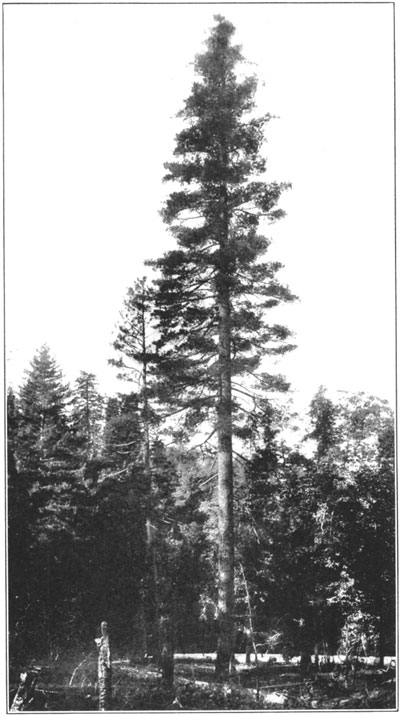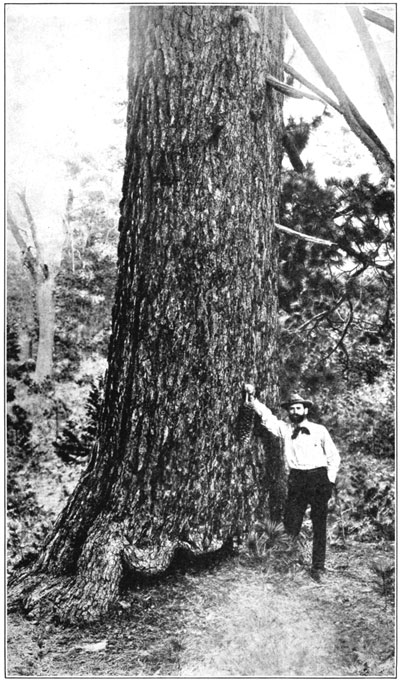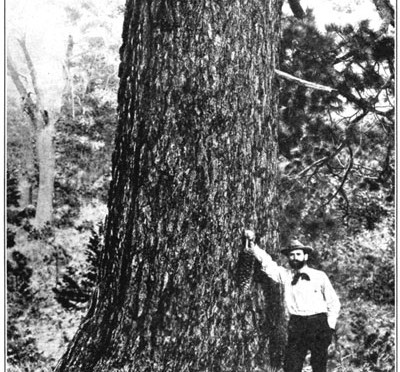Forests of Crater Lake National Park
Sugar Pine (Pinus Lambertiana)
Yellow pine can not, however, have the claim of being the largest and most kingly pine of the Northwest. This distinction belongs to one of its associates, the sugar pine (Pinus lambertiana) of Oregon and California. Around Crater Lake National Park this tree occurs mainly on the lower mountains on the Fort Klamath side, and also on the west slope in the Rogue River drainage extends up to an altitude of about 4,000 feet. It is found only in the extreme southern portion of the park as a rule, extending slightly higher than the yellow pine.
Sugar pine (figs. 4 and 5) seen and recognized once never is forgotten. Forest-grown trees, with their massive, slightly tapering bodies, their open crowns of long, huge branches standing out at right angles from the trunks, and, above all, the clusters of huge cones suspended gracefully from the upturned branch tips, give to this species an individuality that none of its associates possess.

Fig. 4—Sugar pine (Pinus lambertiana) 61 inches in diameter.
The trunks of young sugar pines taper rather rapidly and they are partly clothed with small branches. In their later years the bodies fill out, forming smooth, slightly tapering columns, and all branches are lost except those on the upper part of the tree. On trees of medium and large size the bark is thick, deeply broken up into furrows, and plates covered by reddish and cinnamon-brown scales.
The slender needles of sugar pine are from 2-1/2 inches to 4 inches in length and are deep blue-green in color with a tinge of gray. They are bound in clusters of five, a characteristic of the true white-pine group to which this tree belongs. The huge cones hang on the branch tips for two years before the seeds are liberated, and then fall during the third spring and summer. Usually their length is from 12 to 20 inches, and when their smooth brown scales are fully expanded they are from 1 to 6 inches in diameter.
Sugar pine is found only in Oregon, California, and Lower California, on both sides of the Cascades, from middle Oregon south, mainly along the Cascade Mountains and Sierra Nevada, and also, but to a less extent, in the Coast Range. Nowhere does it form pure forests, but always associates with other species, such as yellow pine, white fire, incense cedar, and Douglas fir.

Fig. 5—Sugar pine (Pinus lambertiana) and cone; tree 6 feet in diameter.
The wood of sugar pine is soft, pale brown in color, and is greatly valued in the lumber industry. It ranks twenty-fourth in the lumber production of the United States, and California produces nearly 98 per cent of the amount cut.
The largest trees occasionally are from 4 to 7 feet in diameter, and lift their topmost twigs nearly 200 feet from the ground. In and around the park the usual size of the mature trees at 200 or 300 years of age is about 3 feet in diameter and 150 feet in height. A tree of these dimensions will scale about 2,000 feet or more, board measure.
Little wonder it is that the cupidity of the lumberman has led to a rapid exploitation of this noble tree. While it is inevitable that it should be largely cut, on account of the great value of the wood, let us hope that many of the largest monarchs may be preserved to add dignity to the future forests of the two States within which it occurs.
There are fine groups of sugar pine at many points along the road from Medford to the park. One tree especially that may be seen about 8 miles north of Prospect is nearly 8 feet in diameter and contains 25,000 feet, board measure, of timber, In ascending Anna Creek, the traveler who does not leave the road will fail to see the finest sugar pines. It is well worth while to wander out into the forest away from the stream, and their find the tree at its best, towering among the yellow pines and firs and scattering its great cones among the ceanothus and chinquapin brush at its feet.
Other pages in this section
*** previous title *** --- *** next title ***


